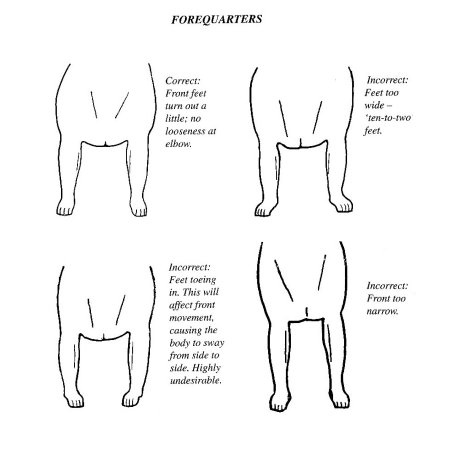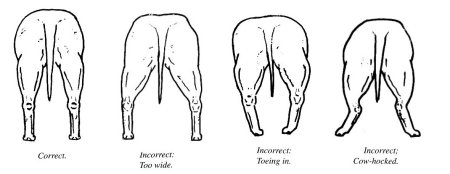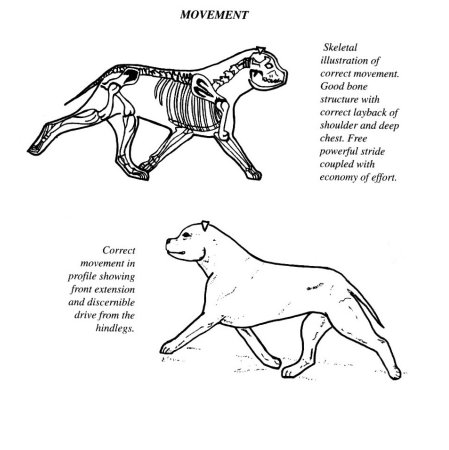|
INTERPRETATION OF THE STANDARD
The Staffordshire Bull Terrier is a smooth-coated dog.
He should be of great strength for his size and although muscular
should be active and agile.
The more enlightened breeder should be guided along a path which aims
for perfection in the Staffordshire Bull Terrier. No two people see
the standard with the same mind's eye view. On the other hand, it is
more important that they not only 'understand' it, but that they can
apply it when they look at specimens they intend to use at stud, and
also, of course, the dogs they integrity is beyond reproach, the
potential use of one or two very good stud dogs. By doing this the
'standard' type of Staffordshire Bull Terrier will soon be not only
implanted in their minds, but there for all to see.
General appearance
The word 'type' is like a piece of elastic - it stretches the whole
way round the dog. He must possess the basis attributes of well-formed
physical features. But to be really good, the Staffordshire Bull
Terrier must also possess what some people would call 'quality'. If an
individual dog has this, it will be stick out like a sore thumb, while
the animal without that 'Q' factor will be just obvious by the
failings in it appearance.
Expression is very important too. That quizzical look on the face - no
wonder the Stafford was called the "laughing dog" - will be missing if
the eyes are wrongly set in the head. This will also happen if they
are too large or too small, or if the colour is wrong.
Although the Staffordshire Bull Terrier is a 'pocket battleship',
elegance is very important, and this comes only from correct balance
and soundness, good, well-shaped bone and proper distribution of the
muscle, which gives that athletic look so important to this breed. The
Stafford's conformation must have complete co-ordination of body and
limbs, to give that beautiful, natural, flowing action, no matter
which angle he is viewed from. All his parts, i.e. head, neck,
shoulders, body, hindquarters should flow into each other to produce a
dog that is ultrasound and a joy to behold on the move. There should
be a free, powerful and agile movement, with economy of effort, legs
moving parallel when viewed front or rear, and discernible drive from
the hindlegs.
Breed type is the quality essential to a dog if he is to have pleasing
balance between correct anatomical structure and general appearance.
Individual type is expressed more by points and detail.
Head and skull
The head should be short, with a deep through broad skull, very
pronounced cheek muscles, a distinct stop, a short foreface, and a
black nose. The Staffordshire Bull Terrier is like lots of other
breeds in that the head is classed as probably the most important part
of its make-up. In other words it is a 'head breed'. The strong broad,
short muzzle and bumpy cheek muscles are in effect the visual and
basic conception of the Stafford as a fighting dog. Most Stafford
breeders and judges work on 2:1 ratio as the ideal proportion of
balance for skull and muzzle. Nostrils should be big and black in a
fighting dog who would need sustaining deep breath in battle. Do not
be misled into giving favours to a doggy-headed bitch, however
tempting she may prove. A bitch should look feminine. The bitch who
carries a 'doggy head' will always pass this on to her female
offspring, who will, all things being equal, always stand second to
the bitch with a more feminine head. The Stafford's head should be
well 'filled up' under the eye, i.e. the surface below the eye should
be filled in, which is what gives the muzzle that deep, strong look.

The shape of the muzzle and formation and development of the jaw
muscles in a fighting dog are of obvious importance, so make sure the
muzzle is deep and strong. The underjaw, when viewed from the front,
should be wide and strong, not shallow or receding.
Eyes
Eyes should be dark but may bear some relation to coat colour, round,
of medium size, and set to look straight ahead. The eyes, they say,
are the windows to the human soul. It is true in the case of dogs, too.
Do not tolerate dogs with bulbous or protruding eyes. Apart from the
vapid, atypical expression they bestow, in a fighting dog such an eye
would be vulnerable.

Ears
Ears play an important part in general appearance. Ears should be
carried alertly. Badly carried ears and big ears detract from the
pleasurable appreciation of a Staffordshire Bull Terrier. The ideal
ear should be small, thin and neat and most importantly, rose-shaped.

The dog should be able to fold them back out in an 'aggro'. It is this
type of era which must receive favour in judging. A fighting dog of
the old days would be at a grave disadvantage with big, thick ears
which any adversary could easily seize and hold.
Mouth
This is probably the most controversial subject in the breed. The
Standard says that the mouth should be level (that is, the incisors of
the lower jaw should fit closely inside the incisors of the top jaw),
the teeth should be big and the lips should be tight and clean. The
badly undershot or overshot mouth should be heavily penalised.

The Standard demands a short foreface but if the muzzle is ultra-short,
there is more chance of the animal being undershot at a later date as
the underjaw gets stronger. This ultra-short muzzle also usually has
the unfortunate habit of producing small teeth. Small, close-knit
teeth are neither typical nor useful in the Staffordshire Bull
Terrier.
Neck
Neck should be muscular, rather short, clean in outline and gradually
widening towards the shoulder. A good head should have a powerful,
muscular neck to support and administrate it. A powerful armament,
such as a typical Staffordshire head represents, is of no value
without the steel spring that a strong neck can emulate, to direct its
action. An overlong neck lacks strength. One which is too short
carries loose skin and dewlap. Both extremes ruin the visual balance
of a dog when viewed from front and side. Both indicate weakness in
physical activity.
Forequarters
The forelegs should be straight and well boned, set rather wide apart
to allow ample chest development. This does not mean they should have
a Bulldog front, but the legs should come directly underneath the dog,
and the bones should be strong and firm with no bend in them. The
whole front should be indicative of great muscular development and
obvious strength. His feet should turn out a little. His shoulders
should be well laid back, which means the shoulders blades should be
at 45 degrees angle, not upright.

Do not be impressed by 'bossy' shoulders, that is, shoulders with
tight, bunchy muscles. If a dog has a well-laid shoulder, you will
find that his front movement is correct, having ample stride and easy
rhythm. Upright shoulders produce a short, mincing movement like that
of a Fox Terrier. The Staffordshire Bull Terrier is noted for his
athletic ability and to have movement like a Fox Terrier would be
disastrous.
Body
The body of a Staffordshire must show to even the casual observer,
great strength for its size and considerable springiness in body
structure. A deep brisket, neck to chest region, should have no
evidence of pinching, and the chest itself should be profound. His
chest should be deep, and elbows should be well laid into his sides
and tucked in. The Stafford is a powerful, compact dog, and should
have a strong back. Try and imagine the dog fitted into a square. If
he fits nicely, he is sure to be compact and well balanced which is
his favour. There should be no drop in the middle of the back, nor
should the back slope away at the croup.

Hindquarters
The Staffordshire Bull Terrier has strong well-muscled hindquarters,
with well let down hocks, and well bent stifles. Well angulated and
powerful hindquarters are very important to the Stafford. Only with
this confirmation can the Stafford have a dynamic thrust it is
renowned for. An old fighting Staffordshire would not have got very
far in combat without well developed hindquarters.

An attacking dog needs powerful hindquarters to push in at his
adversary. When viewed from behind, the legs should be parallel. Keep
an eye open for the faults of 'cow-hocks' when the points of hocks
turn inwards and 'in-toes' when the points of hocks turn outwards.

Feet
The feet should be strong, well-padded and medium size. It should be
well knit, but not a tight foot like that of the cat. This feature was
a very important part of the dog's propulsion, and can be likened to a
top-class sprinter, whose feet, if you watch in slow motion, go from
side to side as he comes out of the blocks. At the point of pasterns
or wrist the feet turn out a little and although this formation
militates a little against stylish forward stance in the show ring it
was a necessary and useful feature in the fighting dog. Such a foot
allowed considerable purchase of movement and maintained balance under
stress.

The approved shape can be likened to hale hare, half cat foot, the
toes well split up and with quite prominent knuckles. Thin, flat feet
and feet with splayed toes are bad faults in an athletic breed.
Tail
Medium length, low set, tapering to a point and carried rather low,
the tail should not curl much and may be likened to an old-fashioned
pump-handle. A tail which measures to the point of hock is about right.
Tail carriage depends largely upon the angle or position of the sacrum
in relation to the spin. The Stafford's tail is like a rudder, which
keeps him on an even keel when he is fighting.

Gait and movement
Movement should be free, powerful and agile, with economy of effort.

Legs should moving parallel when viewed from front or rear, with
discernible drive from the hindlegs. The Stafford has his own style of
movement, front legs mowing neither wide nor narrow, and hindquarters
moving parallel to them.

There should be a rhythm and spring in the stride, and the animal has
to be positive in his action and should not weave or high step. Always
remember that without proper muscular training and ring training, you
will not see the true action so typical of our breed.
Coat
The coat should be smooth, short and close to the skin. It is very
close fitting, but even on hard muscled dogs will tighten closer when
the animal is fighting. The dog's coat will tell you straight away if
he is in good condition, as it should be smooth and have a glisten to
it. There should be no coarse feeling or length on it, which often
suggests that the dog has been kept in cold, draughty conditions.
Staffords thrive in the home and this shows quite clearly in the
showring, where you can always tell the difference between a dog who
has been kennelled and one who lives in the hous.
Colour
The approved colours of Staffords are red, fawn, white, black or blue,
and any of these colours with white, also any shade of brindle or any
shade of brindle with white. Black-and-tan or liver are not to be
encouraged. In fact, in the USA black-and-tan or liver dogs are
disqualified from the sow ring.
Literature:
1. Gilmour D., 1996, The Complete of Staffordshire Bull Terrier,
Ringpress Books Ltd, Lydney,
2. Gordon J.F., 1982, The Staffordshire Bull Terrier, Foyles Handbooks,
The Pitman Press, London. |